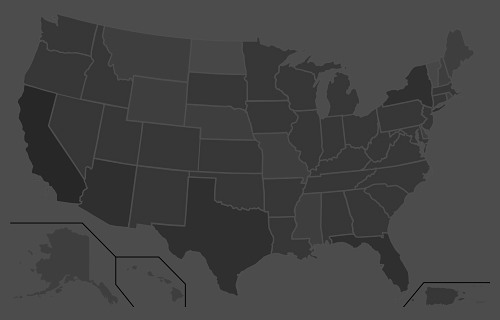“Our added winter moisture and active calling period led to a very long nesting and hatching season, starting in late April and extending into early summer, with chicks hatching as late as early July,” O’Dell said. “From a population standpoint, we are out of a deficit for the first time since 2001-2002. Quail are starting to pop up in places they haven’t been seen in a while.
“If you’ve never had the chance to experience what Arizona quail hunting built its name on, then this would be the year to get out and enjoy it.”
Meanwhile, hunters should note that the season for Mearns’ quail doesn’t begin until Dec. 4. It’s summer rainfall that plays a key role in nesting success and population numbers of this species. After a spotty and relatively weak monsoon across southern Arizona, these birds are likely to be abundant only in pockets that received sufficient precipitation this summer.
A valid Arizona hunting or combination hunt and fish license is required for all hunters 10 and older. Those hunters under 10 must either have a valid hunting or combination hunt and fish license, or be accompanied by an adult who possesses a valid hunting or combination hunt and fish license. Licenses can be purchased online or at license dealers statewide. A youth combination hunt and fish license (ages 10 to 17) is $5.
The general bag limit is 15 quail per day in the aggregate, of which no more than eight may be Mearns’ quail (when the Mearns’ season opens Dec. 4). The general possession limit is 45 quail in the aggregate after opening day, of which no more than 15 Gambel’s, scaled or California quail in the aggregate may be taken in any one day. After the opening of the Mearns’ season, the 45-quail possession limit may include 24 Mearns’ quail, of which no more than eight may be taken in any one day.
More quail-hunting information can be found on the department’s website at https://www.azgfd.com/Hunting/. Another resource for both new and experienced hunters alike is “An Introduction to Hunting Arizona’s Small Game.” Written by Randall D. Babb, the 196-page, full-color book covers where and how to hunt small game birds (like quail), squirrels, rabbits, ducks and geese. It also includes how to prepare and cook your harvest, with illustrations and recipes. The book can be ordered for $16.95 at www.azgfd.gov/publications.
Finally, hunters should check out O’Dell’s techniques for field-dressing quail at https://www.youtube.com/watch?v=3gRwZAcWzzk.
####
Publishers Notes: OUT OF STATE HUNTERS, FISHERMEN & OUTDOOR ENTHUSIASTS; Due to the Covid 19 pandemic, there could be limitations for OUT of STATE hunters, fishermen and other outdoor enthusiasts to include a 14-day quarantine requirement or negative COVID-19 testing alternative. Please check with the State's Department of Natural Resources BEFORE you travel or apply for the 2020 Fall Hunts.
Disclaimer: The views expressed on this site are that of the authors and not necessarily that of TBC Press
States Taking Aggressive Action in Mississippi River for Invasive Carp
Submitted by: TBC Press
Posted on: 05/11/21
The Backcountry Press
The country's premier daily HUNTING, FISHING & OUTDOOR news in the USA and around the globe. Read whats happening in your neck of the woods & beyond.
© 2020 TBC Press - All Rights Reserved Website Design by:
News # 14363
The Mississippi River in Minnesota has healthy populations of native fish and the removal of invasive carp helps to protect those native populations. Any native fish that were incidentally caught in the carp collection efforts were immediately released.
The DNR also continues to track several invasive carp that were previously captured in the Mississippi River, fitted with tracking devices and returned to the river to learn more about their movements and habits. The agency maintains working relationships with commercial fishing operations that assist in the monitoring and detection of invasive carp in the Mississippi River.
Invasive carp have been progressing upstream since escaping into the Mississippi River in Arkansas in the 1970s. These large fish compete with native species and pose a threat to rivers and lakes. No spawning populations have been detected in Minnesota waters to date.
Individual invasive carp have been caught as far upstream as Pool 2 of the Mississippi, near the Twin Cities (bighead, grass, and silver), the King Power Plant on the St. Croix River by Oak Park Heights (bighead), and just downstream of Granite Falls in the Minnesota River (bighead).
The DNR is actively engaged with several other prevention efforts:
- The DNR is an active partner in the Upper Mississippi River Invasive Carp Workgroup. The group includes representatives from Minnesota, Wisconsin, Iowa, Illinois, Missouri, and several federal agencies.
- In partnership with the DNR, the Minnesota Aquatic Invasive Species Research Center at the University of Minnesota is testing and evaluating carp deterrents in Mississippi River locks and dams.
- The DNR’s Fish and Wildlife Division leads a program to monitor fish population changes and impacts of management actions.
- The DNR is designing a process to work closely with stakeholders on updating the Minnesota Invasive Carp Action Plan.
- The DNR is helping to plan an upcoming statewide Invasive Carp Forum hosted by the Stop Carp Coalition.
State funding sources, including the Environmental and Natural Resources Trust Fund and Outdoor Heritage Fund, have provided key funding for deterrent actions and the DNR invasive carp detection and response program.
Invasive carp captures must be reported to the DNR immediately by calling 651-587-2781 or emailing [email protected]. Take a photo and transport the carp to the nearest DNR fisheries office or make arrangements for it to be picked up by a DNR official. Do not release captured invasive carp. A permit can be requested to keep captured invasive carp for personal use.
More information about invasive carp is available on the Minnesota DNR website at https://www.dnr.state.mn.us/invasive-carp/index.html?utm_medium=email&utm_source=govdelivery
####
Publishers Notes: Our country is still battling COVID-19. To avoid the spread of this virus and continue to enjoy outdoor activities, ALL outdoor enthusiasts (man, woman, child) should follow the guidelines set by nps.gov. These guidelines include; social distancing, the Leave No Trace principles, including pack-in and pack-out, to keep outdoor spaces safe and healthy.
The Minnesota Department of Natural Resources, in partnership with the Wisconsin Department of Natural Resources, the U.S. Geological Survey and the U.S. Fish and Wildlife Service, is taking further action following the capture of 34 silver carp in Pool 8 of the Mississippi River near La Crosse, Wis. during a recent Modified Unified Method operation.
Next steps include increased commercial netting operations, tracking tagged carp, and perhaps another Modified Unified Method operation in the Mississippi River.
The USGS-developed Modified Unified Method combines netting and herding techniques to drive and concentrate invasive carp from a large area of water into a small zone for removal. Thirty-one silver carp were captured during the five-day operation earlier this month and three more were captured during follow-up work.
“This innovative multi-agency approach was the first time the Modified Unified Method was used anywhere as an early detection and rapid response technique,” DNR invasive species program supervisor Heidi Wolf said. “It worked so well that we’re already talking about perhaps doing this again next year.”












